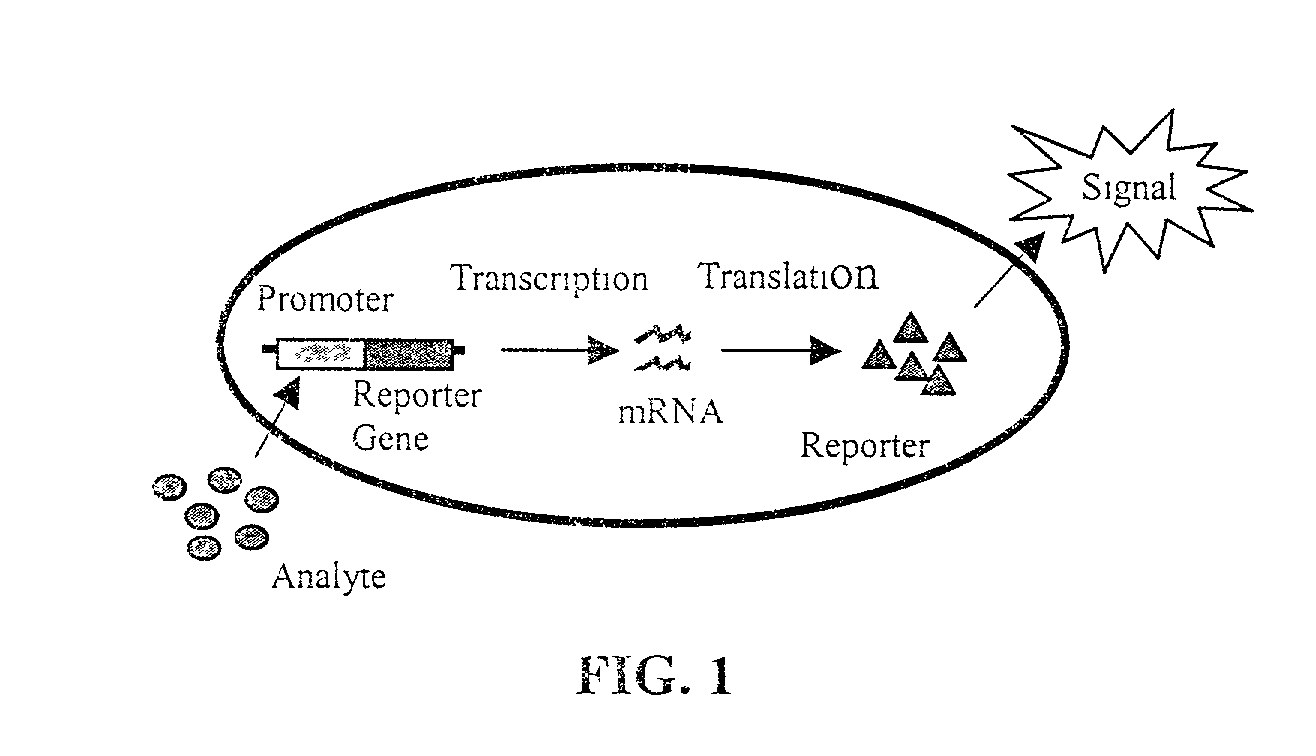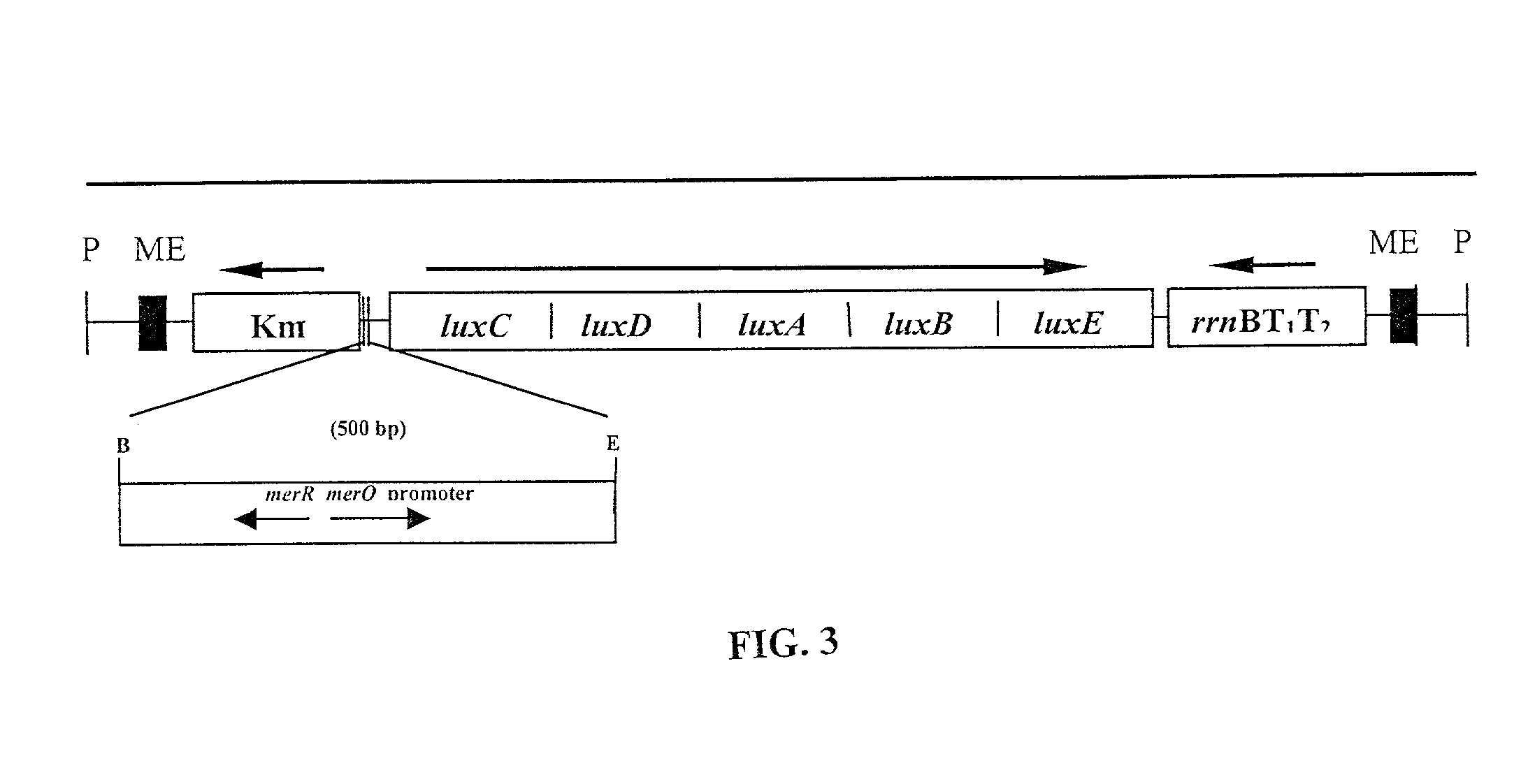Bioluminescent methods for direct visual detection of environmental compounds
a bioluminescent method and environmental compound technology, applied in the field of bioluminescent methods for direct visual detection of environmental compounds, can solve the problems of untested water sources, military personnel, untested water supplies, etc., and achieve the effects of increasing light production, maintaining viability, and reducing the amount of bioluminescen
- Summary
- Abstract
- Description
- Claims
- Application Information
AI Technical Summary
Benefits of technology
Problems solved by technology
Method used
Image
Examples
example 1
5.1 Example 1
Construction of Chromosomally-Based mer-lux Whole Cell Bioluminescent Reporters
[0068] Three bioluminescent reporter strains containing the merR-lux construct incorporated in the E. coli chromosome were constructed as described. A schematic of the pFSP-3 vector used in these constructs including incorporation of the luxCDABE genes, the kanamycin resistance gene, and the termination sequences is shown in FIG. 3. The vector was a gift from Dr. Bruce M. Applegate, (Purdue University, West LayFayette, Ind.).
[0069] A 505 bp merR fragment was previously PCR amplified from the mer operon and cloned into the TA Cloning Vector (pCR2.1; Invitrogen, San Diego, Calif.). Primers (sequence ID 1 and 2; Table 3) for the amplification were synthesized based on the merRo / p sequence listed in GenBank (Accession #AF071413; nucleotides 19133-19638). The source of the mer DNA was pDG106 (Gambill and Summers, 1985). The merR was excised from pCR2.1-merR with EcoRV and BamHI. Plasmid pFSP3 was ...
example 2
5.2 Example 2
Growth of Strains ARL1, ARL2, and ARL3
[0071] The growth rate of the bioluminescent E. coli strains was tested to determine if the mer-lux transposon was incorporated into a critical pathway in E. coli EC 100. Each transposon mutagenized strain, including the unmutagenized host strain, was grown in MSM broth supplemented with glucose (1 g / L), thiamine (1.0 mg / L), isoleucine (100 mg / L) and leucine (100 mg / L). The experiment was performed at 37.degree. C. with shaking. Each growth curve was performed in triplicate. Only minor differences in growth rates were observed (FIGS. 4A and 4B). From the data in FIG. 4B, the doubling time of each strain can be determined by the following equation: T.sub.d=ln 2 divided by the slope of the regression line. From the data, the doubling time for E. coli EC100, ARL1, ARL2 and ARL3 are 1.61, 1.61, 1.67 and 1.58, respectively. These results indicated that there are no significant mutations affecting critical growth pathways in each strain.
example 3
5.3 Example 3
Detection of Mercury Using Bioluminescence
[0072] Strains ARL1, ARL2, and ARL3 were screened for bioluminescence production in the presence of HgCl.sub.2. Each strain was grown in LB medium to an OD.sub.546nm of 0.35 at which time 500 .mu.g HgCl.sub.2 / L was added. Induction of bioluminescence in the presence of mercury was rapid (FIG. 5) with significant light produced in 30 minutes. Strain ARL2 had higher background bioluminescence (.about.31,486 cps) in the absence of mercury relative to strain ARL1 and ARL3 (.about.13,798 and .about.12,762 respectively). After 20 minutes, strain ARL2 produced approximately twice the amount of bioluminescence ((.about.1,791,560 cps) relative to strains ARL1 and ARL3 (.about.917.496 and 825,240 cps respectively).
PUM
| Property | Measurement | Unit |
|---|---|---|
| humidity | aaaaa | aaaaa |
| pore size | aaaaa | aaaaa |
| concentrations | aaaaa | aaaaa |
Abstract
Description
Claims
Application Information
 Login to View More
Login to View More - R&D
- Intellectual Property
- Life Sciences
- Materials
- Tech Scout
- Unparalleled Data Quality
- Higher Quality Content
- 60% Fewer Hallucinations
Browse by: Latest US Patents, China's latest patents, Technical Efficacy Thesaurus, Application Domain, Technology Topic, Popular Technical Reports.
© 2025 PatSnap. All rights reserved.Legal|Privacy policy|Modern Slavery Act Transparency Statement|Sitemap|About US| Contact US: help@patsnap.com



